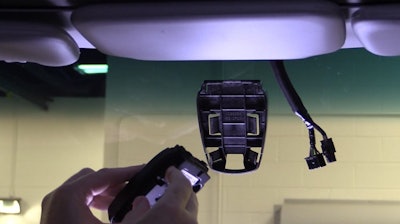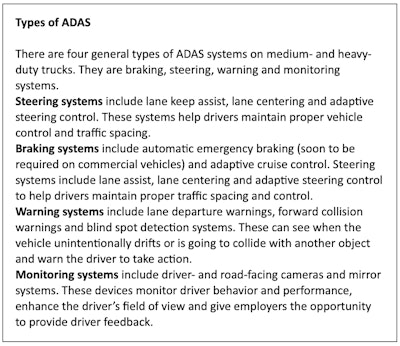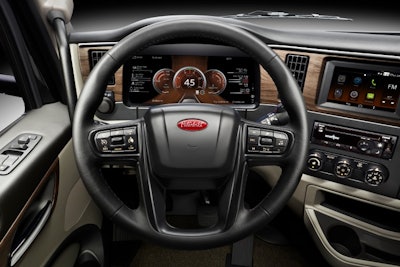
Advanced driver assistance systems (ADAS) are a network of technologies in modern vehicles that help drivers avoid dangerous situations.
These are things such as automatic braking (soon to become legally required on heavy-duty trucks), lane assist and other tech that can extend the field of vision for a driver and keep a truck and trailer out of accidents.
[RELATED: False-positive reports suggest AEBs not ready for prime time]
“There are a number of different systems available on commercial vehicles, either as standard or optional equipment,” says Chuck Brodie, senior field service engineer for ZF Commercial Vehicle Solutions, who makes the OnGuard, ReAX and WABCO OnLane systems. ”Collision mitigation and lane departure warning systems have become standard equipment in recent years. Lane keeping and blind spot detection systems are also being adopted more frequently.”

ADAS comes in four flavors: Steering, braking, warning and monitoring. These systems can be spec’d or added in the aftermarket. But they all have to be connected and calibrated correctly in order to work.
“You’ve got to think of ADAS, of all the electronics, is on top,” says Brian Screeton, supervisor of technical service training at Bendix. Bendix makes the BlindSpotter and Wingman systems. “You have ADAS, stability control, traction control and ABS. ADAS requires all of those subsystems to be in good working order for it to perform fully. It really goes beyond that — the engine, the transmission, all of those other major parts of the truck can have an impact on the performance of the ADAS systems.”
[RELATED: HD Repair Forum stresses necessity of meticulous service for ADAS technologies]
No matter the manufacturer, ADAS components arrive calibrated. But things can happen over the course of a truck’s lifetime that require a recalibration of the system in the shop. There could be maintenance to a camera or radar or a repositioning of a camera on the windshield.
Depending on the system and component, that can either be done in the shop or on the road. Dynamic systems calibrate themselves as the truck is driven. Static calibration may be something as simple as a screw turn to properly align the radar or camera.
“Each system has its own calibration process, so it’s important for technicians to consult the proper repair information before attempting to calibrate a given system,” Brodie says.
 ZF's ADAS systems are now offered on Paccar trucks, such as this Peterbilt.ZF
ZF's ADAS systems are now offered on Paccar trucks, such as this Peterbilt.ZF
Calibrating the Radar
Bendix, Screeton says, is in between generations of radar in its systems. The older systems requires a static set-up wherein the technician aligns the radar. As the system runs, it constantly checks its lateral alignment and will log a fault when it needs an adjustment. The technician then corrects it and resets the system.
“You’re basically telling the radar, ‘I did what you wanted. Start over,’” Screeton says.
WABCO OnLane and ZF’s OnGuardACTIVE systems automatically calibrates as the truck is driven.
“When this system’s radar is replaced, it comes out of the box with alignment mode activated and calibrating it is just a matter of installing it and going for a road drive,” Brodie says. “If an existing radar needs an alignment, the calibration process can be started with WABCO Toolbox Plus software and completed with a road test.”
Calibrating the Camera
Cameras are more tricky.
“With our systems, what is critical is that the camera is located in the correct position on the windshield,” Bendix’s Screeton says. “For it to get the right perspective, the camera has to be in a specific spot. If anything’s ever serviced, the camera has to be put back in that specific spot.”
It’s straightforward enough, Screeton says, but the system won’t work if the camera is even a little off.
“You have to have the right information because that is going to be a different location on different makes and models,” he says.
For ZF and WABCO equipment, the same is true, Brodie says. Cameras need to be installed according to a template specific to that make and model. Calibration is wrapped up by driving the truck so the system can set itself.
Getting it Right
Any system is only as good as it’s inputs. That’s why is vitally important that ADAS components are set correctly.
“These systems are designed to enable safer operation of commercial vehicles on the highway, and exact calibration is essential for accurate alerts and precise, active braking and steering inputs,” ZF’s Brodie says.
Both ZF and Bendix systems will alert the operator should any part cause it to go out of whack, such as if a mounting bracket becomes bent. Then, it’s up to the technician to know which system they’re working with and the requirements for that specific truck.
“There’s several different systems out there for commercial vehicles,” Screeton, from Bendix, says. “Technicians need to read the service information and understand the differences between the systems.”
READ MORE: FMCSA program pushes ADAS installations








